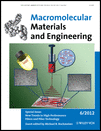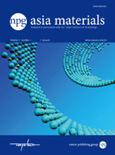
ADVANCED MATERIALS
Scope & Guideline
Transforming Ideas into Advanced Solutions
Introduction
Aims and Scopes
- Nanomaterials and Nanostructures:
Research on the synthesis, properties, and applications of nanomaterials, including nanoparticles, nanocomposites, and nanostructured films, with a focus on their unique electronic, optical, and mechanical properties. - Energy Storage and Conversion Materials:
Development and optimization of materials for energy storage systems, such as batteries and supercapacitors, and conversion technologies, including fuel cells and electrocatalysts, emphasizing efficiency, stability, and sustainability. - Biomaterials and Bioinspired Materials:
Exploration of materials designed for biomedical applications, including drug delivery systems, tissue engineering scaffolds, and biointerfaces, inspired by natural structures and processes. - Smart and Responsive Materials:
Investigation of materials that respond dynamically to external stimuli, such as temperature, light, or pH, including hydrogels, shape-memory polymers, and piezoelectric materials. - 2D Materials and Heterostructures:
Research on two-dimensional materials like graphene and transition metal dichalcogenides, focusing on their integration into electronic, optoelectronic, and energy applications. - Sustainable and Green Materials:
Development of environmentally friendly materials and processes, including biodegradable polymers, renewable resource-based materials, and strategies for recycling and upcycling.
Trending and Emerging
- Smart Textiles and Wearable Devices:
There is a growing emphasis on the development of textiles and wearable devices that integrate sensors and electronics for health monitoring, energy harvesting, and interactive applications. - Photonic and Optoelectronic Materials:
Research on materials that can manipulate light for applications in sensors, displays, and communication technologies is increasing, particularly with advancements in photonic crystals and nanostructures. - Biomimetic and Bioinspired Materials:
Emerging studies are focusing on materials that mimic biological systems for applications in drug delivery, tissue engineering, and regenerative medicine, reflecting a trend towards integrating biology with material science. - Sustainable and Eco-Friendly Materials:
Research in developing biodegradable, recyclable, and environmentally friendly materials is on the rise, driven by global sustainability initiatives and regulatory pressures. - Advanced Electrocatalysts for Energy Applications:
There is an increasing focus on designing novel electrocatalysts for energy conversion and storage applications, particularly for hydrogen production, CO2 reduction, and fuel cells, emphasizing efficiency and stability. - 2D Materials and Hybrid Structures:
The exploration of two-dimensional materials and their hybrid structures is gaining traction, with applications in electronics, photonics, and energy storage, showcasing the potential of these materials in next-generation technologies.
Declining or Waning
- Traditional Bulk Materials:
Research focused on conventional bulk materials, such as metals and ceramics, has diminished as the field shifts towards advanced composites and nanomaterials that offer superior properties and functionalities. - Single-Use Materials:
The interest in materials designed for single-use applications is waning, replaced by a focus on sustainable and recyclable materials that promote circular economy practices. - Basic Characterization Techniques:
Publications centered around fundamental characterization techniques without innovative applications or insights are increasingly less common, as researchers prioritize studies that combine characterization with practical applications. - Conventional Photovoltaic Materials:
Research on traditional photovoltaic materials, particularly silicon-based solar cells, is declining as more attention is given to emerging technologies like perovskite solar cells and organic photovoltaics. - Mechanical Properties of Materials:
While still important, standalone studies focusing solely on mechanical properties without integration into broader applications or interdisciplinary contexts are becoming less frequent.
Similar Journals

Materials Today Advances
Unlocking innovations in materials and mechanical engineering.Materials Today Advances is a premier open access journal, published by Elsevier, dedicated to disseminating cutting-edge research in the fields of Materials Science and Mechanical Engineering. Since its inception in 2019, the journal has quickly established itself within the academic community, achieving an impressive Q1 quartile ranking in both disciplines as of 2023, indicative of its high-impact contributions. Ranked #25 out of 672 in Mechanical Engineering and #46 out of 463 in General Materials Science according to Scopus, Materials Today Advances offers rigorous peer-reviewed articles that address the latest innovations and interdisciplinary approaches. Researchers, professionals, and students can benefit from the journal's open access model, ensuring widespread visibility and accessibility of groundbreaking findings. With the convergence of advanced materials research and practical applications, this journal represents a vital resource for those at the forefront of scientific discovery.

Frontiers of Materials Science
Transforming Ideas into Reality in Materials ResearchFrontiers of Materials Science is a groundbreaking journal dedicated to exploring advanced materials and their applications within the ever-evolving landscape of materials science. Published by HIGHER EDUCATION PRESS, this journal offers a crucial platform for scholars and practitioners seeking to disseminate innovative research findings that foster interdisciplinary collaboration. Since its inception in 2011, the journal has enjoyed a notable Q2 ranking in the category of Materials Science (miscellaneous) as of 2023, positioning it among the noteworthy publications in the field with a Scopus rank of #222 out of 463. While predominantly published in China, the journal is committed to open access principles, allowing global accessibility to cutting-edge research. With its comprehensive coverage spanning materials synthesis, characterization, properties, and applications, Frontiers of Materials Science not only serves as a repository for academia but also bridges the gap between research and industry, making it an indispensable resource for researchers, professionals, and students alike.

MACROMOLECULAR MATERIALS AND ENGINEERING
Catalyzing Collaboration in Macromolecular ResearchMACROMOLECULAR MATERIALS AND ENGINEERING, published by Wiley-VCH Verlag GmbH, is a distinguished open-access journal that since its inception in 1989 has been at the forefront of research in the fields of Chemical Engineering, Materials Chemistry, and Polymer Science. Recognized with a top-tier Q1 ranking in multiple categories for 2023, including Chemical Engineering and Organic Chemistry, this journal facilitates cutting-edge discoveries and advancements by providing a platform for authors to share innovative findings. With an impressive Scopus ranking, positioned within the top percentiles in several interdisciplinary categories, MACROMOLECULAR MATERIALS AND ENGINEERING is an essential resource for researchers, professionals, and students who are engaged in the development and application of macromolecular materials. As an open-access journal since 2023, it enhances accessibility and fosters collaboration within the global scientific community. The journal, headquartered in Germany, aims to publish high-quality, peer-reviewed articles that drive the scientific dialogue forward in the rapidly evolving fields of materials science and engineering.

NPG Asia Materials
Connecting Academia and Industry through Cutting-edge ResearchNPG Asia Materials, a premier journal published by NATURE PORTFOLIO, stands at the forefront of research in the fields of condensed matter physics, materials science, and modeling and simulation. With an impressive Impact Factor gracing its Q1 rankings in 2023, this open-access journal, established in 2012, offers a vital platform for disseminating high-quality research articles, reviews, and perspectives that advance the understanding of material properties and innovative applications. Based in the United States and catering to a global audience, NPG Asia Materials features cutting-edge contributions that not only enhance academic scholarship but also provoke discussions relevant to both industry and academia. Researchers, professionals, and students are invited to explore its extensive archive of work, covering insights from 2009 to 2024, in a bid to stay abreast of the latest developments in these rapidly evolving scientific domains.

Advanced Materials Interfaces
Fostering Collaboration in Materials Engineering ExcellenceAdvanced Materials Interfaces is a premier journal dedicated to the exploration and advancement of materials science, with particular emphasis on the interfacial phenomena that govern the behavior of materials in various engineering applications. Published by WILEY in the United Kingdom, this Open Access journal, established in 2014, has quickly ascended to a Q1 category ranking in both Mechanical Engineering and Mechanics of Materials as of 2023, reflecting its significant influence and excellence in the field. With impressive Scopus Ranks, such as #81 out of 672 in Mechanical Engineering and #58 out of 398 in Mechanics of Materials, it serves as a vital resource for researchers and practitioners aiming to push the boundaries of materials innovation. The journal provides unrestricted access to its cutting-edge research, promoting collaboration and dissemination of knowledge among the global scientific community, solidifying its role as a vital contributor to the ever-evolving landscape of materials engineering.

MACROMOLECULAR RESEARCH
Pioneering Research in Polymer ApplicationsMACROMOLECULAR RESEARCH, published by the POLYMER SOC KOREA, is a premier journal dedicated to advancing the field of macromolecular science and polymer engineering. With its ISSN 1598-5032 and E-ISSN 2092-7673, this journal has emerged as a vital platform for researchers and professionals interested in the application and development of polymers across various domains. Based in South Korea and operating as an open-access resource since its inception in 2002, MACROMOLECULAR RESEARCH consistently ranks in the Q2 category across diverse fields such as Chemical Engineering, Materials Chemistry, and Organic Chemistry as per the latest 2023 metrics. Notably, it is recognized for its substantial contributions to polymery science, increasing its visibility and impact in global research. By providing a forum for original research articles, reviews, and innovative methodologies, this journal aims to foster collaboration and knowledge sharing among scientists, engineers, and students alike. Join a community that is at the forefront of polymer research by exploring the wealth of resources and cutting-edge studies featured in MACROMOLECULAR RESEARCH.

Accounts of Materials Research
Elevating knowledge in the realm of materials chemistry.Accounts of Materials Research is a premier journal published by the American Chemical Society, focusing on the multidimensional field of materials science. With a robust impact factor and a commitment to open-access research, it serves as a vital platform for leading-edge discoveries from 2020 to 2024. The journal has rapidly ascended to the top quartile in multiple categories, including Chemical Engineering, Materials Chemistry, and Polymers and Plastics, demonstrating its significant influence within the academic community. Recognized by Scopus as a key resource—with remarkable rankings that place it in the 95th percentile of its field—Accounts of Materials Research is devoted to publishing high-quality, innovative research that addresses critical challenges in materials development and implementation. This journal is essential for researchers, professionals, and students seeking to stay informed about the latest advancements and collaborative opportunities within the interdisciplinary landscape of materials science.

ACS Materials Au
Exploring the Frontiers of Materials ScienceACS Materials Au, published by the American Chemical Society, is a premier open-access journal that has been at the forefront of materials science since its inception in 2021. With an ISSN of 2694-2461, this journal encompasses an expansive range of topics including biomaterials, electronic, optical and magnetic materials, materials chemistry, and polymers and plastics, consistently achieving Q1 rankings in these categories for 2023. The journal is based in the United States and operates from the AMS's headquarters in Washington, DC, offering significant visibility and a robust platform for researchers. The journal's commitment to open access ensures wide dissemination of groundbreaking research, enabling a diverse audience—including researchers, professionals, and students—to engage with the latest advancements in materials science. With an encouraging impact factor and a focus on novel materials and innovative applications, ACS Materials Au stands as a vital resource for anyone devoted to understanding and advancing the frontiers of materials engineering and science.

Polymer Reviews
Driving excellence in biomedical engineering and beyond.Polymer Reviews, published by Taylor & Francis Inc, is an esteemed journal dedicated to the intricate and evolving field of polymer science. With its ISSN 1558-3724 and E-ISSN 1558-3716, the journal has established a significant presence among researchers and practitioners alike, evidenced by its impressive categorization in the Q1 quartiles across multiple disciplines, including Biomedical Engineering, Materials Chemistry, and Renewable Energy. Since its inception in 2006 and continuing through 2024, Polymer Reviews has consistently aimed to advance the knowledge base of polymer applications and innovations, providing a platform for comprehensive review articles that stimulate further research and inspire practical solutions. The journal, ranking within the top percentile across several Scopus categories, underscores its impact and relevance in a rapidly developing scientific landscape. Though not an open-access journal, it remains a vital resource for those invested in the future of materials science and engineering.

MATERIALE PLASTICE
Unveiling the Potential of Advanced MaterialsMATERIALE PLASTICE is a distinguished academic journal published by REVISTA CHIMIE SRL in Romania, focusing on the fields of Chemistry, Materials Science, and Engineering. With an ISSN of 0025-5289 and an E-ISSN of 2668-8220, this journal has a historical commitment to advancing the study of polymers and plastics since its inception in the early 1970s. Although classified in the Q4 category across multiple disciplines including miscellaneous chemistry and materials chemistry as of 2023, it serves as an important forum for researchers and professionals dedicated to innovative materials research and development. The journal’s resources, though not openly accessible, are pivotal for scholars seeking to deepen their knowledge in the mechanics of materials and interdisciplinary applications. MATERIALE PLASTICE is not only a repository of significant research findings but also a platform for fostering collaboration and discussion among a global audience that continues to strive for scientific excellence in polymer and materials studies.